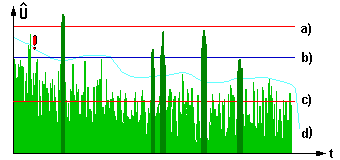False alarm rate
The false alarm rate ( FAR ) is an evaluation measure for the work of a radar device for air reconnaissance. Echo signals are always displayed in the radar receiver against background noise. The noise signals occur in a statistically distributed manner with amplitudes that correspond to those of useful signals and are processed as such. This leads to the display of wrong targets. False alarm rate is the average number of false targets that can be detected at the receiver output in a certain time, for example per antenna revolution or per pulse train period (PRT).
The false alarm rate should have the lowest possible value. It is the ratio of the existing number of false alarms to the maximum possible number of false alarms. A maximum number of false alarms is determined by the number of possible target identifications. With a digital radar, this is the number of range cells . With an analog radar, the maximum number of possible false alarms is determined by the ratio of the reception time to the transmission pulse duration. The false alarm rate can be calculated using the following formula, for example:
The mean level of the noise is set, among other things, by the size of the basic gain of the receiver. A threshold value is used to determine the amplitude up to which the noise is limited and the voltage value from which the targets are displayed. In the graphic opposite, the real target echoes are marked dark green compared to the light green noise. All pulses that exceed the respective voltage value (a to d) are displayed on the display unit. The choice of the threshold voltage now determines the false alarm rate. In practice, with digital target processing, false alarm rates in the order of magnitude of approximately 10 −3 to 10 −4 are tolerated. With an analog display, however, much higher values are accepted, which are then compensated for by the experience of the radar operator.
The false alarm rate and the probability of detection influence each other. Increasing the receiver gain increases the noise level and the false alarm rate increases. At the same time, the probability of detection increases because very weak target characters now exceed the threshold value. When tuning the radar device, an optimal compromise must be found between the two parameters.
Constant False Alarm Rate (CFAR)
In the case of static threshold voltages, the false alarm rate is also dependent on the distance, because the gain of the receiver is controlled as a function of time by the STC circuit . Modern radar devices therefore use circuits that can influence the threshold value as a function of the perceived environmental conditions and cause a constant false alarm rate (CFAR) during the entire duration of the excursion. The threshold value is now no longer a static voltage, but rather a voltage profile adapted, for example, to the mean noise level.

